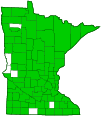field pussytoes
(Antennaria neglecta)
Conservation • Wetland • Description • Habitat • Ecology • Use • Distribution • Taxonomy
Description |
||
Field pussytoes is an erect, perennial forb that rises on a basal rosette of leaves and a flowering stem from fibrous roots and stolons. It often forms colonies. The stolons are 1″ to 7″ long, slender, densely wooly, and leafy. They recline on the ground with the tips ascending. They root at the nodes, forming new plants. Basal leaves are narrowly inversely lance-shaped to narrowly inversely egg-shaped or narrowly spoon-shaped, 1″ to 2½″ long, and ¼″ to 11 ⁄16″ wide. They are rounded or broadly pointed at the tip, and have an abrupt, short, sharp point at the tip. They taper gradually to the leaf stalk at the base. The upper surface is gray and moderately to densely covered with short, matted or tangled, soft, woolly hairs. It becomes green and hairless or nearly hairless with age. The lower surface is densely covered with short, matted or tangled, soft, woolly hairs. The hairiness of the lower surface persists at maturity. There is 1 prominent vein extending from the base to the tip, visible at least on the underside. Occasionally there is also a faint pair of parallel lateral veins. The margins are untoothed. Stem leaves are alternate, linear to narrowly oblong lance-shaped, and 5 ⁄16″ to 1″ long. They taper to a sharp point at the tip and attach to the stem at the base without a leaf stalk. The lowermost leaves are often narrowly inversely lance-shaped. Middle and upper leaves have a short, hairlike extension of the midvein at the tip. The upper and lower surfaces are densely covered with short, matted or tangled, soft, woolly hairs. The flowering stem can be 1½″ to 12″ tall, though it usually reaches no more than 8″ in height. It is erect, sparsely leafy, and densely covered with white woolly hairs. It sometimes becomes hairless in patches with age. There are no purple glandular hairs near the top of the stem. The inflorescence is a dense cluster of 2 to 8 flower heads at the end of the stem. Male and female flowers are borne on separate plants. A colony of plants may have all male plants or all female plants. The whorl of bracts (involucre) subtending a male flower head is ⅛″ to ¼″ long. The involucre subtending a female flower head is ¼″ to ⅜″ long. The tips on the involucral bracts are white. The flower head is ¼″ to ½″ in diameter. It has 20 to 100 or more white or yellow, tubular disk florets and no ray florets. Male florets are ⅛″ to 3 ⁄16″ long. They have 5 stamens with white filaments and brownish-purple anthers. The corollas are obscured by the numerous stamens. Female florets are ⅛″ to ¼″ long. They have one style with a forked, purplish tip. The corollas are obscured by the numerous styles. There is no floral scent. The fruit is a small achene with hairs at the tip. |
||
Height |
||
1½″ to 8″ |
||
Flower Color |
||
White or yellow |
||
Similar Species |
||
Parlin’s pussytoes (Antennaria parlinii) has a taller flowering stalk, up to 6″ tall. The basal leaves are longer and wider. They have 3 to 5 main, parallel veins that are prominent at least on the underside to the broadest part of the leaf. Plantain-leaved pussytoes (Antennaria plantaginifolia) has shorter, wider, spoon-shaped basal leaves, each with 3 to 5 conspicuous veins. It's range in Minnesota is restricted to the southeast corner of the state. |
||
Habitat |
||
Dry to moderate moisture. Fields, woods, prairies. |
||
Ecology |
||
Flowering |
||
April to June |
||
Use |
||
|
||
Distribution |
||||
|
Sources |
|||
| 9/12/2021 | ||||
Nativity |
||||
Native |
||||
Occurrence |
||||
Common |
||||
Taxonomy |
|||
| Kingdom | Plantae (Plants) | ||
| Division | Tracheophyta (Vascular Plants) | ||
| Subdivision | Spermatophytina (Seed Plants) | ||
| Class | Magnoliopsida (Dicots) | ||
Order |
Asterales (Sunflowers, Bellflowers, Fanflowers, and Allies) | ||
Family |
Asteraceae (Sunflowers, Daisies, Asters, and Allies) | ||
| Subfamily | Asteroideae | ||
| Supertribe | Asterodae | ||
| Tribe | Gnaphalieae (paper daisies) | ||
| Genus | Antennaria (pussytoes) | ||
Subordinate Taxa |
|||
Synonyms |
|||
Antennaria angustiarum Antennaria athabascensis Antennaria campestris Antennaria campestris var. athabascensis Antennaria chelonica Antennaria erosa Antennaria howellii var. athabascensis Antennaria howellii var. campestris Antennaria longifolia Antennaria lunellii Antennaria nebraskensis Antennaria neglecta var. athabascensis Antennaria neglecta var. campestris Antennaria parvula Antennaria rousseaui Antennaria wilsonii |
|||
Common Names |
|||
cat’s foot field pussytoes |
|||
Glossary
Bract
Modified leaf at the base of a flower stalk, flower cluster, or inflorescence.
Glandular hairs
Hairs spread over aerial vegetation that secrete essential oils. The oils act to protect against herbivores and pathogens or, when on a flower part, attract pollinators. The hairs have a sticky or oily feel.
Involucre
A whorl of bracts beneath or surrounding a flower, flower head, or flower cluster.
Linear
Long, straight, and narrow, with more or less parallel sides, like a blade of grass.
Node
The small swelling of the stem from which one or more leaves, branches, or buds originate.
Stolon
An above-ground, creeping stem that grows along the ground and produces roots and sometimes new plants at its nodes. A runner.
Visitor Photos |
|||||
Share your photo of this plant. |
|||||
| This button not working for you? Simply email us at info@MinnesotaSeasons.com. Attach one or more photos and, if you like, a caption. |
|||||
Luciearl |
|||||
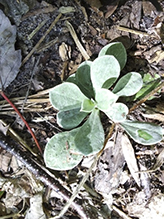 |
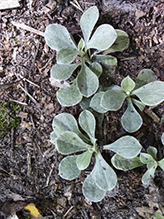 |
||||
MinnesotaSeasons.com Photos |
|||||
Plant |
|||||
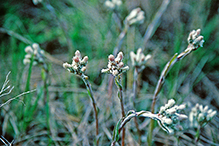 |
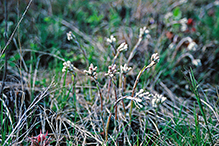 |
||||
Inflorescence |
|||||
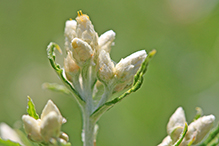 |
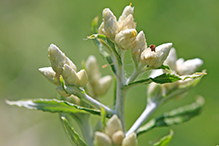 |
||||
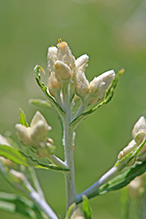 |
|||||

Slideshows |
||
| Pussytoes (Anthennaria neglecta) Andree Reno Sanborn |
||

|
||
| Antennaria neglecta CAT'S PAW Frank Mayfield |
||

|
||

Visitor Videos |
|||
Share your video of this plant. |
|||
| This button not working for you? Simply email us at info@MinnesotaSeasons.com. Attach a video, a YouTube link, or a cloud storage link. |
|||
Other Videos |
|||
| Field Pussytoes (Antennaria neglecta) Wandering Sole TV |
|||
About
Published on Dec 3, 2014 Field Pussytoes (Antennaria neglecta) of the Asteraceae (Aster, Sunflower) family growing in the East Kootenays of British Columbia. |
|||
| MyNature Apps; Identifying Field Pussytoes, Antennaria neglecta MyNatureApps |
|||
About
Uploaded on May 29, 2011 How to identify Field Pussytoes, Antennaria neglecta. Also known as Pointed Little-leaf Pussytoes, Cat's Foot. www.mynatureapps.com |
|||
| How to identify Antennaria neglecta, field pussytoes NY Flora |
|||
About
Published on Apr 14, 2012 Plant characters to look for when identifying this species. Narrated by Steve Young. |
|||

Visitor Sightings |
|||||
Report a sighting of this plant. |
|||||
| This button not working for you? Simply email us at info@MinnesotaSeasons.com. Be sure to include a location. |
|||||
| Luciearl 9/2/2021 |
Location: Cass County |
||||
MinnesotaSeasons.com Sightings |
|||||

|
Created: Last Updated: © MinnesotaSeasons.com. All rights reserved. |
